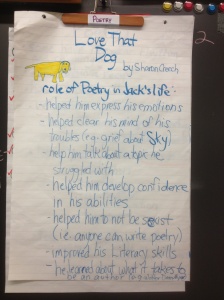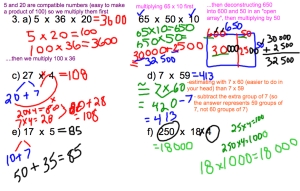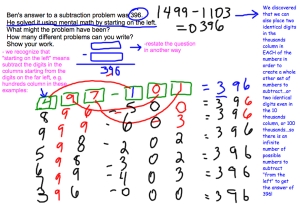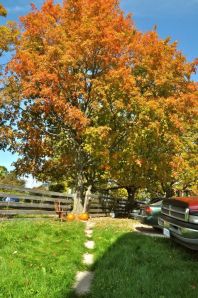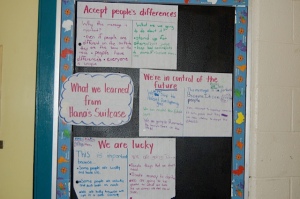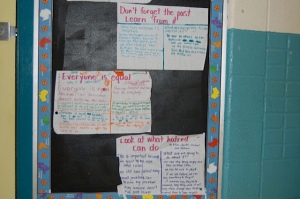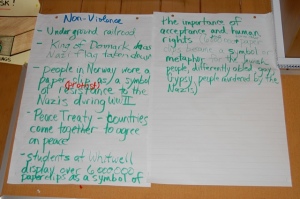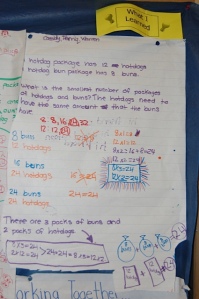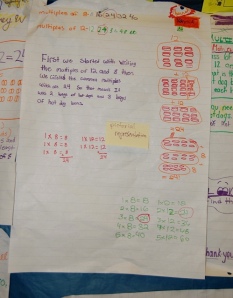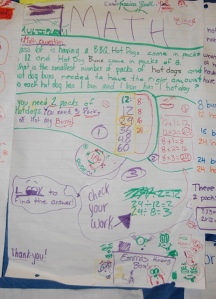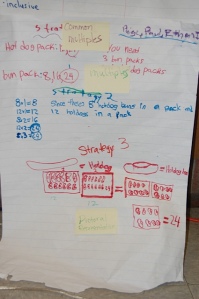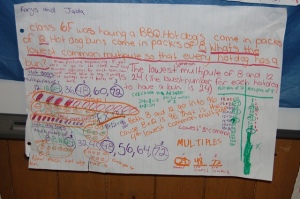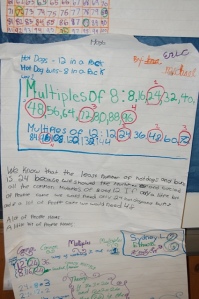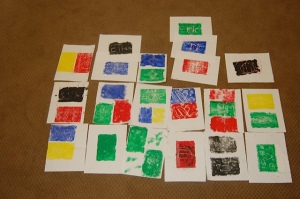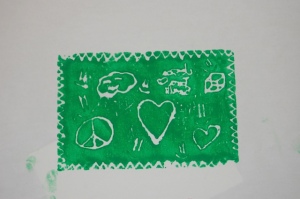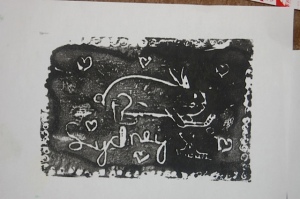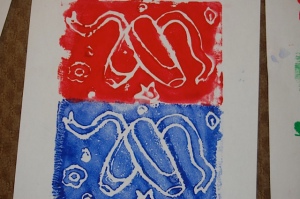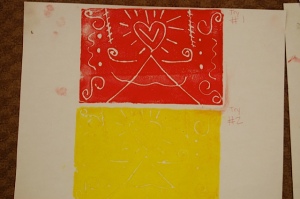Our sixth week of school was great! Slightly colder weather, but that didn’t stop us from enjoying the outdoors (when it was dry!). We will continue to have gym and DPA outside as the weather allows — and we are fortunate to enjoy such a beautiful grassy and treed playground. One of our recess rules is that students must stay on the grassy area and out of the forest areas — we’re looking forward to our grade 6 leaders to keep this rule especially, since the younger students look up to them more than they realize! Any reinforcement at home of this particular rule would be appreciated.
Learning Communities
Speaking of being role models, our first Day 4 Student Learning Community (SLC) session will happen this week. As you may know, Learning Communities has been happening at Rousseau since 2006. We were the first school in HWDSB to schedule concurrent Student and Professional Learning Communities (PLC) (for staff) during instructional time and our school was even recognized at that time by our Board, with a Profiling Excellence Award for this practise. During Learning Communities, classes are paired with younger classes to participate in various learning activities. Our partners this year will be kindergarden students from Mrs. Robinson and Mrs. Crocker’s “A” Day classes and Mrs. Robinson and Ms Hinchey’s “B” Day classes (depending on whether Day 4 is an A or B day). So we are lucky!! We will have two buddies or more (depending on class sizes)! Teachers rotate between supervising these Student Learning Communities and participating in “Professional Learning Communities” where teachers engage in processes of inquiry and learning focused on improving student achievement. Through classroom, school, and large-scale assessments, teachers identify the strengths and needs of a group of students and determine the knowledge and skills required to close gaps that may occur. During some past years, the Student Learning Communities have focused on Character Education and Literacy : students participated in short teacher-led lessons about the importance of Caring, Citizenship, Empathy, Courage, Acceptance, Honesty, Integrity, Respect, Responsibility and Trustworthiness and followed up with a Literacy or Drama activity. At other times, we have focused on reading strategies. This year, Learning Communities has reduced to 24 minutes and there isn’t as much time for any sort of whole group activity or “lesson”. We will maximize the time partners spend together one-on-one this year by having “Buddy Reading” where older students model and practise various reading skills and strategies with their younger partners.
Character Attributes – keeping it positive in Class 6F!
Lessons regarding character attributes are very much embedded in our day and are connected to our curriculum (e.g. social responsibility: how can we think critically about our choices as consumers as they relate to supporting countries who are responsible to their workers; working as a team or group during math to achieve a goal). I refer to the attributes regularly during the school day. The attributes are often important to reinforce during those times when conflicts might arise. Students can tell you that my response to conflicts is to model the attributes and encourage students to practise them. I validate the intrinsic value of all students (Acceptance, Caring), and guide them to see that there is a difference between who they are as a person and the choices that they make (Responsibility, Citizenship). My personal philosophy is very much grounded in the idea that all students are capable and valuable, regardless of the choices they make. If choices are not appropriate, it is important to use the situation as a teachable moment — to recognize what may have led them to make their choice (Empathy), to encourage students to articulate the choices that they made (Courage, Honesty), to brainstorm alternate choices that could have been made and to set goals to make and follow through with different choices in the future (Responsibility, Citizenship, Integrity). There are so many successes in our class — we are a bright bunch of caring people! I always look forward to giving positive feedback, and sometimes this happens in the form of Monthly Character Awards at our monthly assemblies.
One way we are “keeping it positive” in 6F is to validate each other regularly through “Bucket Filling”. We started in September with a great read aloud called, “How Full Is Your Bucket?“. In the book, buckets and water are used as a metaphor for self-esteem: the more we receive positive messages and support, the fuller our bucket. We can also fill our own bucket by giving positive messages and support to others. A “full bucket” results in positive feelings of self-worth and empowerment. This was a great activity for Literacy in general….we made inferences as the story progressed and learned about metaphors and other literary devices. Here are some examples of metaphors we discussed and also a picture of our own labeled buckets, which students regularly fill with positive messages for each other.
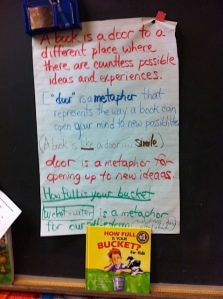
examples of metaphors

our self-esteem buckets!
Literacy
During Literacy this week, we completed reading related to trade (Social Studies) in the Nelson Literacy text, and practised our summarizing skills. We also practised summarizing as our current reading strategy during 20 minute Independent Reading sessions. We also reviewed our Writing — our own story endings to “The Sweetest Fig”. The writing focus for assessment was content and organization. With respect to Reading expectations, we established the fact that there were some very critical inferences that would have been made if students had comprehended the story fully, and we explored student examples to find evidence of those inferences (moderating student work). We also used the text to begin some explicit teacher-directed lessons about how to find evidence to support our Open Response comprehension questions. Here is the question about the central character, Monsieur Bibot, the dentist and the results of our group and classwork in finding evidence to support our inferences.
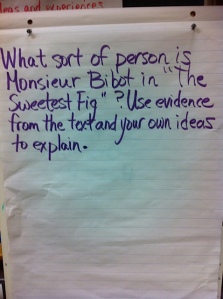
Open Response reading comprehension question
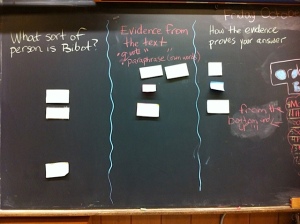
organizing our inferences and evidence from the text
Numeracy
In Math, we continued our exploration of Order of Operations. One challenge that remained was helping students to remember that although division and multiplication are performed before addition and subtraction, the two operations of division and multiplication are themselves performed in the order in which they appear in the mathematical expression (likewise for addition and subtraction). Student wrote a formative assessment, and I suggested that if a student’s individual assessment was really favourable, it could count as a summative assessment for evaluation and reporting. Students requiring reteaching and further practise will have that opportunity.
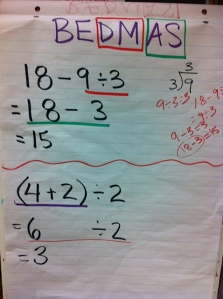
BEDMAS
We also worked on Multiplication this week. In the “Getting Started” portion of the “3- Part Lesson” format, we started with a mental math strategy called “strings”, which helps to show the logic that can be used to break down complex multiplication…..

"strings"
Then in the “Working on It” stage, we worked in teacher -chosen groups (3 students maximum) to explore a word problem…..
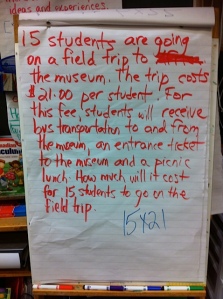
Problem solving question (group work)
And then in the “Reflect and Connect” stage, we shared answers and identified problem solving strategies with stick notes:. pictoral representation, open arrays, standard algorithm (the procedure of multiplication and ‘carrying over’ that many of us learned way back when), partial sums, repeated addition. The goal for a level 4 (“A”) answer is to justify your answer in more than one way. Here are several Level 4 answers. Can you infer why two sample answers are 4+? Students are reminded that although it is important to communicate clearly, it is not necessary that their answers look “beautiful”. We want to see all of their thinking, including errors (which should be simpley “X’d” out, not scribbled) because then we can understand their thought processes. My favourite part of the 3-Part Lesson is Reflect and Connect, where students have the opportunity to share a diverse array of logic and strategies. We need to work further on establishing group work routines — students are learning as much about themselves during group work as they are about math!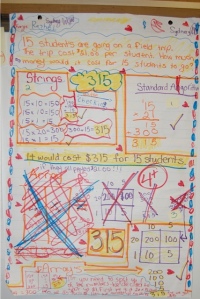
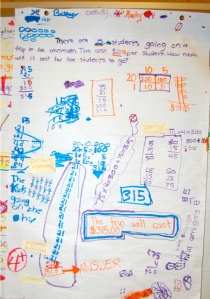
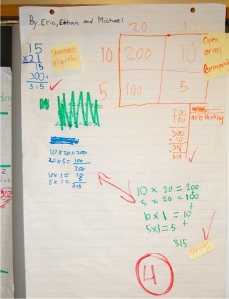
The week ahead….
In Literacy, we will work on organizing our evidence in reading comprehension and refining our skills in communicating our evidence. In Numeracy, we will practice multiplication individually (especially the organization part) and assess multiplication, as well as revisit Order of Operations and re-asssess as necessary on a student-by-student basis. We will be continuing Trade in Social Studies….and of course a wide variety of activities in other curriculum areas: singing, sports, health, etc..
Have a super week!


